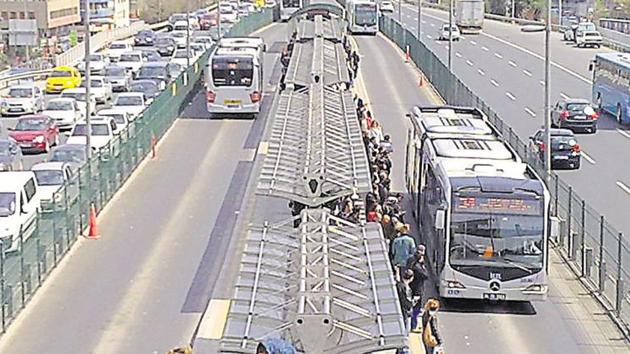World cities checked vehicular congestion through creativity, not by widening roads
If the problem is to solve the movement of passengers between Delhi and Gurugram, then what can be the solution, if not a road through the biodiversity park?
Last week, I wrote about why the proposed six-lane expressway through Gurugram’s biodiversity park would be a disaster. Since then, I have gotten many messages asking what is the alternative to resolve the congestion between Delhi and Gurugram?

So, this time, I asked Avira, my nine-year-old daughter about what causes congestion in Gurugram. Her one-word reply was ‘cars’. I was not surprised by her response. Let’s get one thing right, congestion on road happens not because that road is narrow but because the number of cars and two-wheelers on these roads exceeds its actual capacity.
One way to attempt resolving the congestion is by increasing the road space by road widening, flyovers or creating a new road altogether. The other way is by restricting the number of vehicles on road. The third could be a combination of both the strategies.
However, most Indian cities use only the supply side approach for addressing congestion. This means if you have congestion, supply more roads. But it doesn’t seem to work as our roads continue to remain congested.
The question, therefore, is ‘what’s the alternative?’ Let’s frame it this way — if the problem is to solve the movement of passengers between Delhi and Gurugram, then what can be the solution, if not a road through the biodiversity park? Let me give three examples on how some of the other countries have addressed this issue:
Road Pricing, Singapore
In 1998, Singapore became the first city in the world to implement the Electronic Road Pricing (ERP) system for resolving congestion. As part of the ERP, motorists are charged depending on the congestion they cause. This means that the rate varies depending on the size of the vehicle, but also changes with regards to time of usage. This means higher charges during peak hours, lower in off-peak period. A total of 3,200 kilometres of road, including 164 kilometres of expressways and 604 kilometres of main roads are covered under the ERP. Payments for ERP vary for different half-hours from Rs150 (for a car) during the peak hours to Rs50 during the off-peak periods. The initial impact analysis showed that traffic volume on the expressways reduced by 15% while the speed increased from 35 to 55 kmph during the peak hours. ERP has succeeded in easing congestion and encouraging commuters to walk, cycle and use public transport, as an alternative.
Parking Management, San Francisco
Many cities have increased the supply of parking by building multilevel car parks, but on-street spaces have been neglected too often. The result is that almost 50 to 60% of the road space gets occupied by on-street parking, causing congestion. In order to resolve this issue, the city of San Francisco implemented SFPark, an innovative and new parking and traffic demand management system. As part of the programme, parking information data was made available to people so that they could find the information without driving for the same. SFPark periodically adjusts the parking price to match demand and supply. This encourages people to park in underused areas, reducing demand in overused areas. SFPark is the first large-scale experiment on regulating on-street parking. Going by the impact on improved parking availability and reduced congestion, it is a huge success.
Prioritising Transit, Istanbul
The Bosphorus Bridge once faced extreme congestion. People driving from the European part of Istanbul to the Asian and vice-versa were stuck for hours, much more than what the wait time on the NH-8 or MG Road between Gurugram and Delhi. But instead of creating a new bridge or widening the existing one, the city authorities decided to develop a simple, yet effective solution. They came up with a 42-kilometre service, the MetroBus, a bus-based mass transit system along the D-100 Expressway that connects both sides of the city across the Bosphorus Bridge.
The buses get segregated lanes on the expressway and head via queue jumpers at the bridge, due to which they complete the entire journey in 60 minutes against the two hours for cars. The high-capacity buses ferry 200 passengers, each at 30-second intervals, and transport around 30,000 passengers in each direction. Many cities have successfully used buses for mass transit but the beauty in the MetroBus system in Istanbul is that it is being successfully used for an expressway and that’s great.
Roads are to a city like arteries are to a human body. If they get blocked, the impact is catastrophic. However, when an artery starts getting blocked, the cardiologist asks the person to go on a diet, which simply means controlling the intake (food and drinks) and exercise. This is exactly what we need to do to the roads — put them on a diet, i.e., restricting private automobile use and increasing walking, cycling and using public transport.
If we are able to put cites on a road diet, we would not only save many biodiversity parks, but would also increase the quality of life in our cities.
(Amit Bhatt is the director integrated transport at Wriindia)
Stay updated with all the Breaking News and Latest News from Mumbai. Click here for comprehensive coverage of top Cities including Bengaluru, Delhi, Hyderabad, and more across India along with Stay informed on the latest happenings in World News.
Stay updated with all the Breaking News and Latest News from Mumbai. Click here for comprehensive coverage of top Cities including Bengaluru, Delhi, Hyderabad, and more across India along with Stay informed on the latest happenings in World News.






